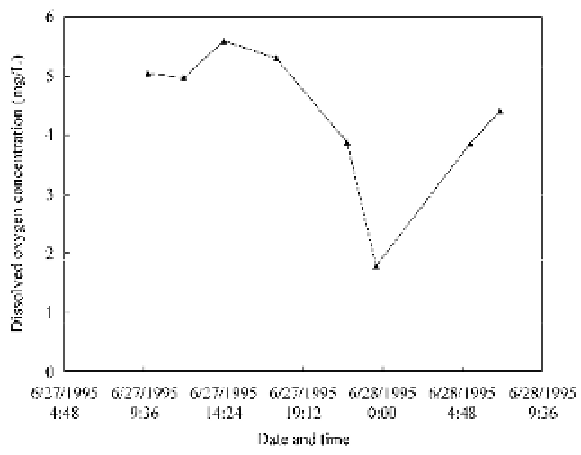Environmental Engineering Reference
In-Depth Information
(2) the hours of daylight;
(3) the warmer (growing) seasons of the year.
Thomann (1972, p. 105) notes that when dealing with photosynthesis a higher order biological system
is involved relative to the CBOD, NBOD, and SOD relations. In large part this higher order results from
the multiple types of plants in the aquatic system engaging in photosynthesis, including:
(1) phytoplankton or free floating aquatic plants with no motility of their own,
(2) aquatic weeds that may be attached to the river bed or free floating, and
(3) the attached algae (periphyton) clinging to rocks, stems, and other surfaces.
As indicated in Eq. (9.26), photosynthesis requires light energy, thus, during the night, aquatic plants
respire consuming oxygen from the water and releasing CO
2
into the water. The production of DO during
the day by photosynthesis and the consumption of DO at night by respiration leads to a diurnal cycle in
the DO concentrations that can have a significant impact on the ability of a stream to meet dissolved
oxygen standards (Section 9.3.8). Figure 9.10 shows the diurnal fluctuation in DO concentrations in Salt
Creek in the western suburbs of Chicago, U.S., for June 27-28, 1995. It can be seen that during the daylight
hours on June 27
th
, 5 mg/L or more of DO are present in the stream, but once the sun goes down the DO
drops to unacceptably low concentrations (as low as 1.79 mg/L around midnight on the 27
th
). For this case
the diurnal range in DO concentrations is a little less than 4 mg/L. However, for rivers that experience
supersaturation during the day the nightly DO concentrations may be near zero and the diurnal range can
be more than 10 mg/L.
Fig. 9.10
Diurnal fluctuation in dissolved oxygen concentrations in Salt Creek at Elmhurst, Illinois, U.S., for June 27
and 28, 1995
As seen in Fig. 9.10, the photosynthesis-respiration process is very complex. With respect to the DO
balance, net photosynethetic oxygen production (the difference between gross photosynthetic production,
P
, and respiration,
R
) primarily depends on:
(1) radiant light energy received at specific depths in the river,
(2) nutrient (particularly nitrogen and phosphorus) concentrations,
(3) dissolved oxygen, and
(4) water temperature.


Search WWH ::

Custom Search